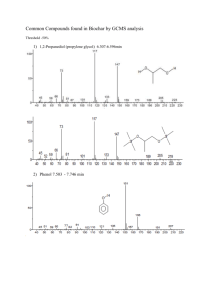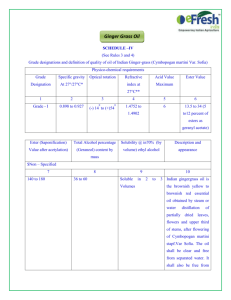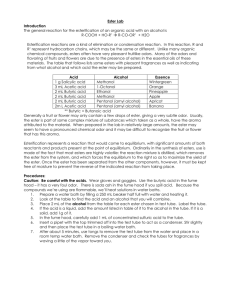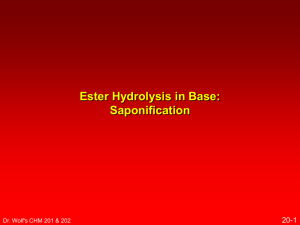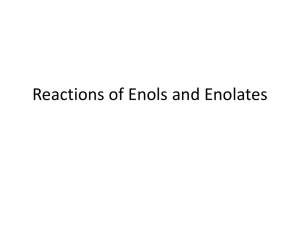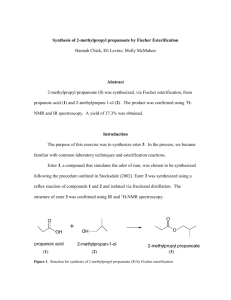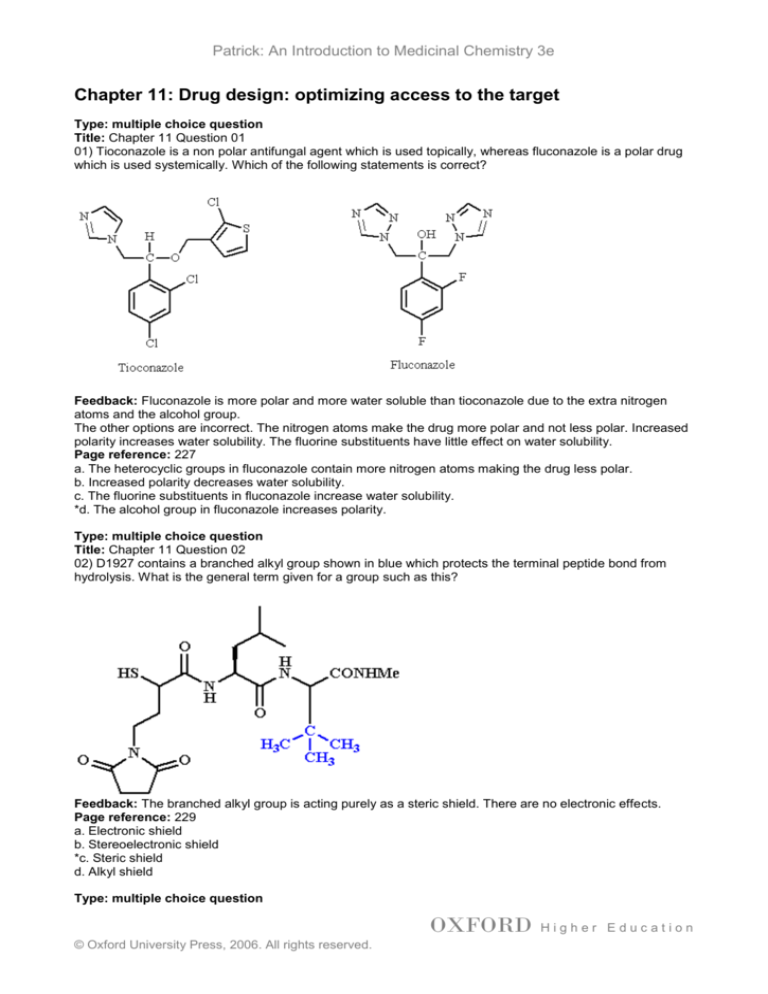
Patrick: An Introduction to Medicinal Chemistry 3e
Chapter 11: Drug design: optimizing access to the target
Type: multiple choice question
Title: Chapter 11 Question 01
01) Tioconazole is a non polar antifungal agent which is used topically, whereas fluconazole is a polar drug
which is used systemically. Which of the following statements is correct?
Feedback: Fluconazole is more polar and more water soluble than tioconazole due to the extra nitrogen
atoms and the alcohol group.
The other options are incorrect. The nitrogen atoms make the drug more polar and not less polar. Increased
polarity increases water solubility. The fluorine substituents have little effect on water solubility.
Page reference: 227
a. The heterocyclic groups in fluconazole contain more nitrogen atoms making the drug less polar.
b. Increased polarity decreases water solubility.
c. The fluorine substituents in fluconazole increase water solubility.
*d. The alcohol group in fluconazole increases polarity.
Type: multiple choice question
Title: Chapter 11 Question 02
02) D1927 contains a branched alkyl group shown in blue which protects the terminal peptide bond from
hydrolysis. What is the general term given for a group such as this?
Feedback: The branched alkyl group is acting purely as a steric shield. There are no electronic effects.
Page reference: 229
a. Electronic shield
b. Stereoelectronic shield
*c. Steric shield
d. Alkyl shield
Type: multiple choice question
OXFORD
© Oxford University Press, 2006. All rights reserved.
Higher Education
Patrick: An Introduction to Medicinal Chemistry 3e
Title: Chapter 11 Question 03
03) Methicillin was an important penicillin which was effective in the 1960's against penicillin G resistant
strains of S. aureus. Although the drug is more effective than penicillin G against resistant strains, it is not as
active against strains which are susceptible to penicillin G. The methyl substituents of the aromatic ring play
an important role in the drug's effectiveness against penicillin G resistant strains. Which of the following
statements is the most likely explanation?
Feedback: The β-lactam ring is susceptible to β-lactamase enzymes produced by some bacteria. These
enzymes open up the β -lactam ring and deactivate the penicillin. The methyl groups on the aromatic ring of
methicillin shield the lactam ring from attack.
Page reference: 229, 399
a. The methyl groups act as steric shields to protect the aromatic ring from oxidation by metabolic enzymes
in the body.
*b. The methyl groups act as steric shields to protect the β-lactam ring from hydrolysis by enzymes
produced by resistant bacteria.
c. The methyl groups act as conformational blockers to orientate the aromatic ring out of the plane of the
side chain amide group, allowing better binding interactions with the target enzyme.
d. The methyl groups increase the electron density of the aromatic ring allowing better binding interactions
with the target enzyme.
Type: multiple choice question
Title: Chapter 11 Question 04
04) How does adrenaline prolong the local anaesthetic activity of procaine?
Feedback: Adrenaline constricts blood vessels and helps to localise procaine at the site of injection. The
other options are wrong. There is no complex formed between adrenaline and procaine. Adrenaline does not
block the metabolic enzymes attacking procaine and adrenaline does not sensitise the receptors for
procaine.
Page reference: 243
a. It forms a complex with procaine which acts as a more powerful local anaesthetic.
b. It blocks metabolic enzymes that would normally inactivate procaine.
*c. It constricts blood vessels and helps to localise procaine at the site of injection.
d. It sensitises the receptors normally occupied by procaine.
Type: multiple choice question
Title: Chapter 11 Question 05
05) Why do many drugs containing ester functional groups have a limited duration of action?
Feedback: Esters are fairly easily hydrolysed by enzymes called esterases in the blood supply. If the ester
is important for a binding interaction, the drug will have a limited duration of action.
The other options are wrong. Ester groups do not increase polarity as much as a free carboxylic acid or
alcohol would. Drugs containing ester functional groups can cross cell membranes relatively easily and
some ester prodrugs are used to enhance oral absorption.
If the ester was hindering access to the target binding site, the drug would have poor activity rather than a
poor duration of activity.
Esters are not as polar as the constituent carboxylic acid and alcohol. As a result, they should be excreted
more slowly.
Page reference: 236
a. The ester groups make the drug more polar and reduce absorption.
*b. The ester groups are susceptible to esterase enzymes.
c. The ester groups act as steric shields and prevent drugs entering binding sites.
OXFORD
© Oxford University Press, 2006. All rights reserved.
Higher Education
Patrick: An Introduction to Medicinal Chemistry 3e
d. Drugs with ester groups are rapidly excreted by the kidneys.
Type: multiple choice question
Title: Chapter 11 Question 06
06) Many drugs containing ester functional groups have a limited duration of action. There are several
strategies which can be used to avoid this problem. Which of the following is not a suitable strategy?
Feedback: Adding an electron withdrawing group to the alkoxy moiety of the ester is more likely to increase
its susceptibility to hydrolysis and not decrease it. This is because the alkoxide leaving group would be
stabilised by an electron withdrawing group, making it a better leaving group.
Replacing the ester group with an amide or replacing the ester group with a urethane will stabilise the
functional group since both groups contain a nitrogen with a lone pair of electrons which will interact with the
neighbouring carbonyl group to make it less reactive to nucleophiles. Adding a steric shield close to the
ester will stabilise the group since the steric shield will hinder the approach of attacking nucleophiles.
Page reference: 236
a. Replacing the ester group with an amide.
b. Adding a steric shield close to the ester.
*c. Adding an electron withdrawing group to the alkoxy moiety of the ester.
d. Replacing the ester group with a urethane.
Type: multiple choice question
Title: Chapter 11 Question 07
07) What is the most plausible explanation for the fact that some drugs containing an ester group are
inactive in vitro, but are active once the drug has been absorbed in vivo?
Feedback: These drugs are described as prodrugs. They do not bind to a target binding site in vitro since
an important binding group has been masked by the ester. In vivo, the ester group is hydrolysed to reveal
the binding group.
The other proposals are not impossible but are more unlikely.
Page reference: 236
a. The ester can only bind to its target when the target is present in the body. If the target is isolated for in
vitro studies, the ester cannot bind to it since an important cofactor is missing.
*b. The ester group is hydrolysed by esterases in the body to produce the active drug.
c. The targets used for in vitro tests undergo conformational changes which disguise their binding sites and
prevent the ester from binding in vitro. The ester binds to the target in vivo.
d. The ester forms a complex with an endogenous molecule before binding to the target binding site.
Type: multiple choice question
Title: Chapter 11 Question 08
08) Megestrol acetate has a short duration of activity since it is metabolised at position 6. Placing a methyl
group at the 6-position increases the duration of action. What role does the methyl group play?
Feedback: The methyl group acts as a blocker and prevents the metabolic enzyme attacking the 6 position.
The other options are all incorrect: it would be rather pointless adding a group to prevent one metabolic
reaction if it was susceptible to another. The steroid skeleton is rigid and does not have a variety of
conformations available to it. The answer 'it is an electron donating group' is an accurate statement, but the
electron donating effect of the group is not the reason it blocks metabolism. It is a steric effect.
Page reference: 230-231
OXFORD
© Oxford University Press, 2006. All rights reserved.
Higher Education
Patrick: An Introduction to Medicinal Chemistry 3e
a. It is a susceptible metabolic group.
*b. It is a metabolic blocker.
c. It is a conformational blocker.
d. It is an electron donating group.
Type: multiple choice question
Title: Chapter 11 Question 09
09) Salbutamol is an anti-asthmatic agent which shows an improved activity over previous catechol like
compounds
What feature of salbutamol is crucial to this increased duration of action?
Feedback: The alcohol group represents a group shift where a functional group is retained but shifted to a
different part of the skeleton. In this case, one phenol of the original catechol ring was shifted one carbon
unit away from the aromatic ring. This makes it less susceptible to metabolism.
Page reference: 231-232
a. The tertiary butyl group
b. The secondary alcohol
c. The phenol
*d. The primary alcohol
Type: multiple choice question
Title: Chapter 11 Question 10
10) Salbutamol is an anti-asthmatic agent which shows an improved activity over previous catechol like
compounds
What strategy was used in order to attain the improved duration of action?
Feedback: A group shift is where a functional group is retained but shifted to a different part of the skeleton.
In this case, one phenol of the original catechol ring was shifted one carbon unit away from the aromatic
ring. It could also be argued that the strategy was a chain extension since a methylene group has been
inserted between the OH group and the aromatic ring.
Page reference: 231-232
a. Substituent variation
*b. Group shift
OXFORD
© Oxford University Press, 2006. All rights reserved.
Higher Education
Patrick: An Introduction to Medicinal Chemistry 3e
c. Chain contraction
d. Simplification
Type: multiple choice question
Title: Chapter 11 Question 11
11) Salbutamol is an anti-asthmatic agent which shows an improved activity over previous catechol like
compounds.
What was the rationale behind the strategy to attain the improved duration of action?
Feedback: The phenol group that was shifted was susceptible to metabolism but it was also an important
binding group for the target binding site. Shifting it one carbon unit away from the ring made it
unrecognisable to the metabolic enzyme but it was still recognisable to the target binding site.
The hydrogen bonding group was already there and so the introduction of a hydrogen bonding group was
not the rationale behind this strategy.
The other options are not irrational but this was not the reason for carrying out this strategy.
Page reference: 231-232
*a. To shift the position of an important binding group such that it is not recognised by metabolic enzymes.
b. To introduce a group which fits a binding region more closely.
c. To move an important binding group such that it interacts more strongly with a binding region.
d. To introduce a group capable of H-bonding.
Type: multiple choice question
Title: Chapter 11 Question 12
12) Why should the introduction of an ester group into the main skeleton of a drug decrease the drug's
duration of action?
Feedback: Esters are prone to hydrolysis by esterases to generate more polar carboxylic acids and
alcohols which are rapidly excreted.
The other options are wrong. The introduction of an ester will not result in that large an increase in polarity.
The molecular weight may not be altered very much by the introduction of an ester. In any case, the level of
absorption will not affect the lifetime of the drug once it is in the blood supply. Esters are generally not very
reactive and do not react with proteins.
Page reference: 233
a. It makes the drug more polar and increases the rate of excretion.
b. It increases the molecular weight of the drug and reduces the amount of drug absorbed.
c. It reacts with proteins in the body such that the drug is irreversibly linked to the proteins by a covalent
bond.
*d. It is hydrolysed by esterases to an alcohol and a carboxylic acid which are quickly excreted due to
increased polarity.
Type: multiple choice question
Title: Chapter 11 Question 13
13) Why should the addition of an alcohol or phenol group to a drug decrease the drug's duration of action?
Feedback: An alcohol or phenol group is commonly subject to phase II metabolic reactions where polar
molecules are linked to the group. The increase in polarity results in rapid excretion and a shorter duration of
action.
OXFORD
© Oxford University Press, 2006. All rights reserved.
Higher Education
Patrick: An Introduction to Medicinal Chemistry 3e
That it increases the polarity of the drug and reduces the amount of drug absorbed is certainly true but a
reduction in the amount of drug absorbed is not relevant to the lifetime of the drug in the blood supply once
the drug has been absorbed. It would be true to say that the increase in polarity will also increase the rate of
excretion.
That it reacts with proteins in the body such that the drug is irreversibly linked to the proteins by a covalent
bond is wrong. An alcohol or phenol functional group is not a highly reactive group and drugs containing it
should not form irreversible covalent bonds with proteins.
That it acts as an electron withdrawing group and affects the binding strength of important binding groups
may be true depending on the structure of the drug and its target, but this is a pharmacodynamic issue and
has nothing to do with the pharmacokinetics of the drug and how long it survives in the body.
Page reference: 233
*a. It acts as a 'polar handle' for conjugation reactions. The conjugates are excreted more quickly.
b. It increases the polarity of the drug and reduces the amount of drug absorbed.
c. It reacts with proteins in the body such that the drug is irreversibly linked to the proteins by a covalent
bond.
d. It acts as an electron withdrawing group and affects the binding strength of important binding groups.
Type: multiple choice question
Title: Chapter 11 Question 14
14) Levodopa is used as a pro-drug for dopamine since it enters the brain more efficiently than dopamine.
Why?
Feedback: The pro-drug is more polar due to the extra carboxylic acid group, and so it crosses the blood
brain barrier less effectively.
The molecule still has the catechol system which is susceptible to metabolism.
Page reference: 237
a. It is more polar and crosses the blood brain barrier more effectively.
b. It is less polar and crosses the blood brain barrier more effectively.
*c. It mimics an amino acid and takes advantage of carrier proteins in order to cross the blood brain barrier.
d. It is less susceptible to metabolism.
Type: multiple choice question
Title: Chapter 11 Question 15
15) What role does carbidopa have in the treatment of Parkinson's disease?
Feedback: Carbidopa inhibits a decarboxylase enzyme in the periphery such that L-Dopa remains intact
and is not converted to dopamine. Carbidopa is too polar to cross the blood brain barrier and does not inhibit
the enzyme in the brain. As a result, L-Dopa is only converted to dopamine in the brain where it is needed.
Page reference: 242-243
a. It binds to dopamine receptors in the brain and acts as an agonist.
b. It binds to dopamine receptors in the brain and acts as an antagonist.
c. It inhibits a decarboxylase enzyme in the brain.
*d. It inhibits a decarboxylase enzyme in the periphery.
Type: multiple choice question
OXFORD
© Oxford University Press, 2006. All rights reserved.
Higher Education
Patrick: An Introduction to Medicinal Chemistry 3e
Title: Chapter 11 Question 16
16) The following structure (III) is used as a prodrug for oestrone. What structures are formed following ester
hydrolysis?
Feedback: Lysine is a natural amino acid which is released after hydrolysis of the ester. Since it is a natural
amino acid, no toxic by products are formed as a result of prodrug activation.
Serine, arginine and histidine contain different functional groups on their side chain from the primary amino
group present on lysine.
Page reference: 240
a. Oestrone and serine
b. Oestrone and arginine
*c. Oestrone and lysine
d. Oestrone and histidine
Type: multiple choice question
Title: Chapter 11 Question 17
17) What expression is used to describe drugs which have been designed from peptide lead compounds,
but which lack peptide character?
Feedback: Peptidomimetics are drugs that have been developed from peptide lead compounds but which
lack peptide character. Antipeptides is a figment of the imagination. Peptoids are peptides where Nsubstituted glycine units are linked together. Antibodies are proteins which are part of the immune response,
and which recognise antigens present in foreign cells.
Page reference: 245
a. Antipeptides
*b. Peptidomimetics
c. Peptoids
d. Antibodies
Type: multiple choice question
Title: Chapter 11 Question 18
18) Which polymer has been attached to proteins to increase a protein's solubility and stability, as well as
decreasing the likelihood of an immune response?
Feedback: Polyethylene glycol or PEG has been used to increase the solubility and stability of proteins, and
to decrease the chances of an immune response. The PEG molecules can be viewed as hydrophilic
polymeric shields.
The other polymers mentioned have no such applications.
Page reference: 245
a. Polythene
b. Polyvinylchloride
*c. Polyethylene glycol
d. Polyurethane
Type: multiple choice question
Title: Chapter 11 Question 19
19) There are several strategies for stabilising susceptible bonds in peptides. Which of the following is not
used in this respect?
Feedback: L-Amino acids are the natural enantiomers in human proteins, and so replacing an L-amino acid
with a D-amino acid is often used to stabilise a susceptible peptide bond.
OXFORD
© Oxford University Press, 2006. All rights reserved.
Higher Education
Patrick: An Introduction to Medicinal Chemistry 3e
Page reference: 245-247
a. Replacing a peptide link with a stable functional group.
b. Adding an N-methyl group to the peptide link.
c. Using an unnatural amino acid.
*d. Replacing a D-amino acid with an L-amino acid.
Type: multiple choice question
Title: Chapter 11 Question 20
20) Oligonucleotides suffer disadvantages as drugs since they are susceptible to enzyme catalysed
degradation. Which of the following enzymes is mainly responsible for this?
Feedback: Nucleases catalyse the hydrolysis of phosphate links. Peptidases catalyse the hydrolysis of
peptide bonds. Lipases catalyse the breakdown of fats, and oxidases catalyse oxidation reactions.
Page reference: 247
a. Peptidases
*b. Nucleases
c. Lipases
d. Oxidases
Type: multiple choice question
Title: Chapter 11 Question 21
21) What kinds of modifications have been carried out on oligonucleotides to make them more stable?
Feedback: All of the above strategies have been tried. Modifications to the phosphate group have resulted
in agents which have been introduced to the clinic.
Page reference: 247-248
a. Modifications to the phosphate group
b. Modifications to the sugar group
c. Modifications to the nucleic acid base
*d. All of the answers are correct
Type: multiple choice question
Title: Chapter 11- Question 22
22) Which of the following strategies will not increase the polarity and water solubility of a drug?
Feedback: Removing polar functional groups will decrease polarity and water solubility. The other options
all increase the polar character of the drug and will increase water solubility.
Page reference: 226-227
*a. Removing polar functional groups.
b. Removing extra alkyl groups.
c. Replacing an aromatic ring with a nitrogen containing heterocyclic ring.
d. Replacing an alkyl group with a smaller alkyl group.
Type: multiple choice question
Title: Chapter 11- Question 23
23) Losartin was developed from structure (I) as an antihypertensive agent by replacing a carboxylic acid
group with a tetrazole ring. Which of the following statements is incorrect?
OXFORD
© Oxford University Press, 2006. All rights reserved.
Higher Education
Patrick: An Introduction to Medicinal Chemistry 3e
Feedback: The tetrazole ring is acidic which is one of the reasons why it can be used as a bio-isostere for a
carboxylic acid group.
Page reference: 229
a. The tetrazole ring represents a bio-isostere.
b. The tetrazole ring mimics a carboxylic acid in being planar.
*c. The tetrazole ring is basic rather than acidic and so cannot mimic a carboxylic acid's acidic nature.
d. The tetrazole ring is less polar than a carboxylic acid.
Type: multiple choice question
Title: Chapter 11- Question 24
24) Chlorpropamide has a longer antibiotic activity than tolbutamide.
Which of the following structures is the most likely metabolite of tolbutamide?
Feedback: Exposed methyl groups are susceptible to metabolic oxidation which suggests that metabolites
A and C are likely. However, the fact that a chloro substituent in chlorpropamide prolongs activity suggests
that it is structure A that is the major metabolite. The chloro substituent in chlorpropamide is resistant to
metabolic oxidation.
Page reference: 231
*a. Structure A
b. Structure B
c. Structure C
d. Structure D
Type: multiple choice question
Title: Chapter 11- Question 25
25) Lidocaine is a longer lasting local anaesthetic than procaine. Which of the following statements is true?
OXFORD
© Oxford University Press, 2006. All rights reserved.
Higher Education
Patrick: An Introduction to Medicinal Chemistry 3e
Feedback: Lidocaine has an amide group which is more resistant to hydrolysis and which is also protected
by the two methyl steric shields on the aromatic ring. As a result the options 'lidocaine is less stable to
hydrolysis' and 'the methyl substituents in lidocaine decrease stability' are wrong.
The amino group plays no role in the stability of the molecule. It is present as an extra binding group for the
target binding site.
Page reference: 230
a. Lidocaine is less stable to hydrolysis.
b. The methyl substituents in lidocaine decrease stability.
*c. The amide group in lidocaine increases stability.
d. The NH2 group in procaine makes procaine less stable than lidocaine.
Type: multiple choice question
Title: Chapter 11- Question 26
26) Carbachol is more stable than acetylcholine to hydrolysis. Which of the following statements is true?
Feedback: Acetylcholine is metabolised by esterases which hydrolyse the ester group. It is not metabolised
by cytochrome p450 enzymes.
Replacing the acyl methyl group of acetylcholine with an amino group alters the ester functional group to a
urethane functional group. Urethanes are more resistant to hydrolysis since the nitrogen's lone pair interacts
with the neighbouring carbonyl group and makes it less reactive to nucleophiles such as water. The
urethane NH2 occupies the same binding region as the original methyl group and there are no additional
binding interactions.
Page reference: 568-569
a. The blue coloured methyl group of acetylcholine is susceptible to oxidation by cytochrome p450 enzymes.
b. The blue coloured nitrogen of carbachol acts as an extra binding group.
c. Carbachol contains a urethane group while acetylcholine contains an ether group.
*d. The blue coloured NH2 group of carbachol is a bio-isostere for the blue coloured CH3 group of
acetylcholine.
Type: multiple choice question
Title: Chapter 11- Question 27
27) Which of the following definitions best describes a prodrug?
Feedback: Prodrugs normally undergo a metabolic reaction in the body to produce an active compound. A
drug that activates a receptor rather than deactivating it is an agonist.
Page reference: 236
a. A drug that activates a receptor rather than deactivating it.
b. A naturally occurring compound that can be converted synthetically into an active compound.
*c. A compound that is inactive, but which is converted to an active compound in the body.
d. A drug which has been approved for clinical purposes by a regulatory authority.
Type: multiple choice question
Title: Chapter 11- Question 28
OXFORD
© Oxford University Press, 2006. All rights reserved.
Higher Education
Patrick: An Introduction to Medicinal Chemistry 3e
28) L791456 is an anti-arthritic drug.
Which of the following structures is not a likely metabolite?
Feedback: A chloro group is resistant to metabolism and is often incorporated into a molecule to block
metabolism at a particular part of the molecule.
Page reference: 233
*a. Structure A
b. Structure B
c. Structure C
d. Structure D
Type: multiple choice question
Title: Chapter 11- Question 29
29) In Parkinson's disease, there is a lack of the neurotransmitter dopamine in the brain. Adding dopamine
itself is not very effective for a variety of reasons. Which of the following statements is a valid explanation?
Feedback: Dopamine is metabolised to inactive metabolites, and this is one of the reasons why dopamine
itself is not a very effective treatment for Parkinson's disease.
The other options are incorrect. Dopamine cannot cross the blood brain barrier, but it is because it is too
polar rather than insufficiently polar. Dopamine is chemically stable and it shows no selectivity between the
dopamine receptors in the brain and the periphery. This is also a reason for it being an unsatisfactory
treatment.
Page reference: 237, 242-243
a. Dopamine is not sufficiently polar to cross the blood brain barrier
b. Dopamine is chemically unstable
*c. Dopamine is metabolised to inactive metabolites
d. Dopamine shows selectivity for peripheral dopamine receptors over dopamine receptors in the brain
Type: multiple choice question
Title: Chapter 11- Question 30
30) Esters are frequently used as prodrugs. Which of the following statements is false?
OXFORD
© Oxford University Press, 2006. All rights reserved.
Higher Education
Patrick: An Introduction to Medicinal Chemistry 3e
Feedback: The answer is correct to the extent that the preferred leaving group should be a natural
compound. However, it is wrong to state that a volatile leaving group is preferred. Formaldeyde is a toxic
compound and, although it is released by some prodrugs, a natural alternative would be advantageous.
Page reference: 236
a. Ester prodrugs are more easily absorbed from the gut than the parent drug.
b. Esters are more susceptible to hydrolysis if the alcohol moiety has an electron withdrawing group.
c. Esters can be used to mask a polar alcohol, phenol or carboxylic acid group.
*d. It is preferable if the leaving group from ester hydrolysis is a natural chemical such as an amino acid or a
volatile compound such as formaldehyde.
Type: multiple choice question
Title: Chapter 11 - Question 31
31) Fluphenazine decanoate is an ester prodrug for the antipsychotic drug fluphenazine and is administered
by intramuscular injection. Which of the following statements best explains its effectiveness?
Feedback: Fluphenazine decanoate is a prodrug where an important binding group (the alcohol) is masked
as an ester. Hydrolysis of the ester reveals the active drug.
Page reference: 239
*a. Hydrolysis of the ester reveals an alcohol group on fluphenazine.
b. The ester is hydrophobic which means that it crosses the blood brain barrier more swiftly.
c. The ester is hydrophilic and rapidly enters the blood supply.
d. The ester is rapidly hydrolysed in blood since the pH of blood is slightly alkaline.
Type: multiple choice question
Title: Chapter 11- Question 32
32) Structures (I) and (II) are prodrugs of the antibiotic chloramphenicol. Which of the following statements is
true?
Feedback: Structure I has a hydrophobic ester which lowers water solubility. As a result, it reduces the bitter
taste of the drug when it is taken by mouth. Structure II has a polar ester due to the carboxylic acid, and so it
has good water solubility. It can be used to achieve high concentrations of the drug for injection.
Page reference: 240-241,
*a. Structure I is less water soluble than chloramphenicol.
OXFORD
© Oxford University Press, 2006. All rights reserved.
Higher Education
Patrick: An Introduction to Medicinal Chemistry 3e
b. Structure II is less water soluble than chloramphenicol.
c. Structure I is used to achieve higher concentrations for injections.
d. Structure II is used to reduce the bitter taste of chloramphenicol.
Type: multiple choice question
Title: Chapter 11- Question 33
33) Which of the following statements is true with respect to phosphate prodrugs?
Feedback: Phosphate esters are more polar and more water soluble than the parent drug. As a result, they
are less likely to cross cell membranes. They are susceptible to metabolism. Otherwise they would not be
prodrugs!
Page reference: 241
a. Phosphate esters are less polar in nature than the parent drug.
b. Phosphate esters are less water soluble than the parent drug.
*c. Phosphate esters are less likely to cross cell membranes than the parent drug.
d. Phosphate esters are resistant to drug metabolism.
Type: multiple choice question
Title: Chapter 11- Question 34
34) Candoxatril is an ester prodrug for candoxatrilat which inhibits protease enzymes. Which of the following
statements is incorrect?
Feedback: The bicyclic system certainly speeds up the rate of ester hydrolysis, but it is because it is
electron withdrawing and not electron donating.
Page reference: 237
a. Hydrolysis of the ester reveals a carboxylic acid group on candoxatrilat.
b. The parent drug cannot be administered orally, whereas the ester can.
c. The bicyclic leaving group is non-toxic.
*d. The bicyclic system is electron donating and speeds up the rate of ester hydrolysis.
Type: multiple choice question
Title: Chapter 11- Question 35
35) Some peptides and proteins have been used as drugs. Which of the following statements is untrue?
Feedback: One of the problems with peptides and proteins as drugs is the fact that they generally show
poor bioavailability.
The other statements are true. Proteins and polypeptides are large molecules and can induce an immune
response. They are poorly absorbed when taken orally due to their polar nature. The peptide bonds are also
prone to hydrolysis by digestive and metabolic enzymes.
Page reference: 244-245
a. Protein drugs suffer a disadvantage in that they could produce an immune response.
*b. Peptides and proteins generally show good bioavailability.
c. Peptide drugs are susceptible to peptidase enzymes.
d. Peptide drugs are susceptible to metabolic and digestive enzymes.
Type: multiple choice question
Title: Chapter 11- Question 36
OXFORD
© Oxford University Press, 2006. All rights reserved.
Higher Education
Patrick: An Introduction to Medicinal Chemistry 3e
36) There are several strategies for stabilising susceptible bonds in peptides. Which of the following is not
used in this respect?
Feedback: An ester bond is just as likely to be susceptible to hydrolysis as a peptide bond due to the
presence of esterases.
Page reference: 245-247
*a. Replacing a peptide link with an ester
b. Adding an N-methyl group to the peptide link
c. Using an unnatural amino acid
d. Replacing an L-amino acid with a D-amino acid
OXFORD
© Oxford University Press, 2006. All rights reserved.
Higher Education


